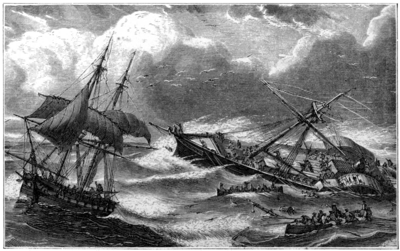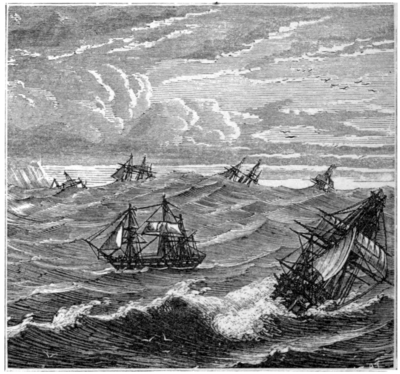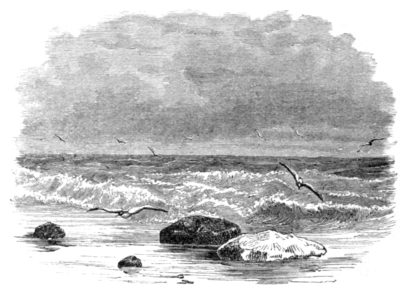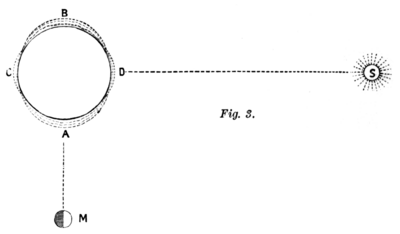
CHAPTER III.
 HEN a man stands on the deck of some tight-built ship, holding on to the weather bulwarks, and gazing with unphilosophic eye through the blinding spray at the fury of the tempest—by which the billows are made to roll around him like liquid mountains, and the ship is tossed beneath him like a mere chip, the sport and plaything of the raging waters—he is apt to think, should his thoughts turn in that direction at all, that all is unmitigated confusion; that the winds, which blew west yesterday and blow east to-day,—shifting, it may be, with gusty squalls, now here, now there, in chaotic fury,—are actuated by no laws, governed by no directing power.
HEN a man stands on the deck of some tight-built ship, holding on to the weather bulwarks, and gazing with unphilosophic eye through the blinding spray at the fury of the tempest—by which the billows are made to roll around him like liquid mountains, and the ship is tossed beneath him like a mere chip, the sport and plaything of the raging waters—he is apt to think, should his thoughts turn in that direction at all, that all is unmitigated confusion; that the winds, which blew west yesterday and blow east to-day,—shifting, it may be, with gusty squalls, now here, now there, in chaotic fury,—are actuated by no laws, governed by no directing power.
Yet no thought could be more unphilosophical than this. Apart altogether from divine revelation, by which we are informed that “all deeps, fire, and hail, snow, and vapour, and stormy wind,” are “fulfilling God’s word” (which information we are bound to receive as a matter of faith if we be Christians, and as a matter of necessity if we be men of common sense, because it is mere absurdity to suppose that the “stormy winds,” &c., are not fulfilling God’s word—or will), we now know, to a great extent from practical experience and scientific investigation, that the winds blow and the waters of the ocean flow in grand, regular, uninterrupted currents. Amongst these there are numberless eddies, which, perhaps, have tended to fill our minds with the idea of irregularity and confusion; but which, nevertheless, as well as the grand currents themselves, are subject to law, and are utterly devoid of caprice.
In regard to these matters there is much about which we are still in ignorance. But the investigations of late years—especially those conducted under the superintendence of Captain Maury of the American Navy, and Drs. Carpenter and Thompson of England—have shown that our atmosphere and our ocean act in accordance with a systematic arrangement, many facts regarding which have been discovered, and turned, in some cases, to practical account.[1]
A very interesting instance of the practical use to which scientific inquiry can be turned, even in its beginnings, is given by Maury. After telling us of the existence and nature of a current in the ocean called the Gulf Stream, he gives the following account of the manner in which upon one occasion he made use of his theoretical knowledge:—
In the month of December 1853, the fine steam-ship San Francisco sailed from New York with a regiment of United States troops on board, bound for California by way of Cape Horn. She was overtaken, while crossing the Gulf Stream, by a gale of wind, in which she was dreadfully crippled. Her decks were swept, and, by one single blow of those terrible seas that the storms raise in the Gulf Stream, more than in any other part of the Atlantic, one hundred and seventy-nine souls, officers and soldiers, were washed overboard and drowned.
The day after this disaster she was seen by one vessel, and again, the next day, December 26th, by another; but neither of them could render her any assistance.
When these two vessels arrived in the United States and reported what they had seen, the most painful apprehensions were entertained by friends for the safety of those on board the steamer. Vessels were sent out to search for and relieve her. But where should these vessels go? Where should they look?
An appeal was made to know what light the system of researches carried on at the National Observatory concerning winds and currents could throw upon the subject.
The materials they had been discussing were examined, and a chart was prepared to show the course of the Gulf Stream at that season of the year. Two revenue cutters were then appointed to proceed to sea in search of the steamer, and Maury was requested to “furnish them with instructions.”
It will be observed here that the gentleman thus appealed to was at the time engaged in his study at Washington, utterly ignorant of all that had occurred within the previous few weeks on the stormy Atlantic, except through the reports brought thence by ships. These reports furnished him with meagre data to proceed upon: simply that a crippled steamer had been seen in a certain latitude and longitude on a particular day.
But this information was sufficient for the practical man of science. Proceeding upon the supposition that the steamer had been completely disabled, he drew two lines on the chart to define the limits of her drift. This his previous knowledge of the flow of the Gulf Stream at all seasons of the year enabled him to do. Between these two lines, he said, the steamer, if she could neither steam nor sail after the gale, had drifted. And that she could neither steam nor sail he had good reason to suppose from the account of her brought in by the vessels above mentioned. A certain point was marked on the chart as being the spot where the searching vessels might expect to fall in with the wreck.
While these preparations were being, made, two ships fell in with the wreck and relieved the crew. This, however, was not known at the time by the anxious friends on shore. The cutters sailed on their mission, and reached the indicated spot in the sea, where, of course, their assistance was now unnecessary. But when the vessels that had relieved the crew of the wreck arrived in harbour and reported where the wreck had been last seen, it was found to be within a few miles of the spot indicated by Maury!
Thus, upon very slight data, a man of science and observation was enabled, while seated in his study, to follow the drift of a wrecked vessel over the pathless deep, and to indicate to a rescue party, not only the exact course they ought to steer, but the precise spot where the wreck should be found.
The waves of the ocean are by no means so high as people imagine. Their appearance in the Atlantic or Pacific, when raised by a violent storm, is indeed very awful, and men have come to speak of them as being “mountains of water.” But their sublime aspect and their tumultuous state of agitation have contributed much to deceive superficial observers as to their real height. Scientific men have measured the height of the waves.
Not many years ago a vessel, while crossing the Atlantic, was overtaken by a violent storm. The sea rose in its might; the good ship reeled under the combined influence of wind and waves. While the majority of the passengers sought refuge from the 
RESCUE OF THE “SAN FRANCISCO.”

A GREAT WAVE AT THE CAPE OF GOOD HOPE.
Waves travel at a rate which increases in proportion to their size and the depth of water in which they are formed. Every one knows that on most lakes they are comparatively small and harmless. In some lakes, however, such as Lake Superior in North America, which is upwards of three hundred miles long, the waves are so formidable as to resemble those of the ocean, and they are capable of producing tremendous effects. But the waves of the sea, when roused to their greatest height, and travelling at their greatest speed, are terrible to behold. Their force is absolutely irresistible. Sometimes waves of more than usually gigantic proportions arise, and, after careering over the broad sea in unimpeded majesty, fall with crushing violence on some doomed shore. They rush onward, pass the usual barriers of the sea-beach, and do not retire until horrible devastation has been carried far into the land.
Maury gives the following anecdote from the notes of a Russian officer, which shows the awful power of such waves:—
“On the 23rd of December 1854, at 9.45 A.M., the shocks of an earthquake were felt on board the Russian frigate Diana, as she lay at anchor in the harbour of Simoda, not far from Jeddo in Japan. In fifteen minutes afterwards (10 o’clock) a large wave was observed rolling into the harbour, and the water on the beach to be rapidly rising. The town, as seen from the frigate, appeared to be sinking. This wave was followed by another; and when the two receded, which was at fifteen minutes past ten, there was not a house, save an unfinished temple, left standing. These waves continued to come and go until half-past two P.M., during which time the frigate was thrown on her beam-ends five times; a piece of her keel, eighty-one feet long, was torn off; holes were knocked in her by striking on the bottom, and she was reduced to a wreck. In the course of five minutes the water in the harbour fell, it is said, from twenty-three to three feet, and the anchors of the ship were laid bare. There was a great loss of life; many houses were washed into the sea, and many junks carried up—one two miles inland—and dashed to pieces on the shore. The day was beautifully fine, and no warning was given of the approaching convulsion: the sea was perfectly smooth when its surface was broken by the first wave.”
Monster waves of this kind occur at regular intervals, among the islands of the Pacific, once and sometimes twice in the year; and this without any additional influence of an earthquake, at least in the immediate neighbourhood of the islands, though it is quite possible that earthquakes in some remote part of the world may have something to do with these waves.
One such wave is described as breaking on one of these islands with tremendous violence. It appeared at first like a dark line, or low cloud, or fog-bank, on the sea-ward horizon. The day was fine though cloudy, and a gentle breeze was blowing; but the sea was not rougher, or the breaker on the coral reef that encircled the island higher, than usual. It was supposed to be an approaching thunder-storm; but the line gradually drew nearer without spreading upon the sky, as would have been the case had it been a thunder-cloud. Still nearer it came, and soon those on shore observed that it was moving swiftly towards the island; but there was no sound until it reached the smaller islands out at sea. As it passed these, a cloud of white foam encircled each and burst high into the air. This appearance was soon followed by a loud roar, and it became evident that the object was an enormous wave. When it approached the outer reef, its awful magnitude became more evident. It burst completely over the reef at all points, with a deep, continuous roar; yet, although part of its force was thus broken, on it came, as if with renewed might, and finally fell upon the beach with a crash that seemed to shake the solid earth; then, rushing impetuously up into the woods, it levelled the smaller trees and bushes in its headlong course; and, on retiring, left a scene of wreck and desolation that is quite indescribable.
“Storm-waves” as those unusually gigantic billows are called, are said to be the result of the removal of atmospheric pressure in certain parts of the ocean over which a storm is raging. This removal of pressure allows the portion thus relieved to be forced up high above the ordinary sea-level by those other parts that are not so relieved.
The devastating effects of these storm-waves is still further illustrated by the total destruction of Coringa, on the Coromandel Coast, in 1789. During a hurricane, in December of that year, at the moment when a high tide was at its highest point, and the north-west wind was blowing with fury, accumulating the waters at the head of the bay, three monstrous waves came rolling in from the sea upon the devoted town, following each other at a short distance. The horror-stricken inhabitants had scarcely time to note the fact of their approach, when the first wave, sweeping everything in its passage, carried several feet of water into the town. The second swept still further in its destructive course, inundating all the low country. The third, rushing onward in irresistible fury, overwhelmed everything, submerging the town and twenty thousand of its inhabitants. Vessels at anchor at the mouth of the river were carried inland; and the sea on retiring left heaps of sand and mud, which rendered it a hopeless task either to search for the dead or for buried property.
We have spoken of waves “travelling” at such and such a rate, but they do not in reality travel at all. It is the undulation, or, so to speak, the motion of a wave, that travels; in the same manner that a wave passes from one end of a carpet to the other end when it is shaken. The water remains stationary, excepting the spray and foam on the surface, and is only possessed of a rising and sinking motion. This undulatory motion, or impulse, is transmitted from each particle of water to its neighbouring particle, until it reaches the last drop of water on the shore. But when a wave reaches shallow water it has no longer room to sink to its proper depth; hence the water composing it acquires actual motion, and rushes to the land with more or less of the tremendous violence that has been already described.
Waves are caused by wind, which first ruffles the surface of the sea into ripples, and then, acting with ever-increasing power on the little surfaces thus raised, blows them up into waves, and finally into great billows. Sometimes, however, winds burst

SCATTERED INTO FOAM.
upon the calm ocean with such sudden violence that for a time the waves cannot lift their heads. The instant they do so, they are cast down and scattered in foam, and the ocean in a few minutes presents the appearance of a caldron of boiling milk! Such squalls are extremely dangerous to mariners, and vessels exposed to them are often thrown on their beam-ends, even though all sail has been previously taken in. Generally speaking, however, the immediate effect of wind passing either lightly or furiously over the sea is to raise its surface into waves. But these waves, however large they may be, do not affect the waters of the ocean more than a few yards below its surface. The water below their influence is comparatively calm, being affected only by ocean currents.
The tides of the sea—as the two great flowings

THE FLOWING TIDE.
and ebbings of the water every twenty-four hours are called—are caused principally by the attractive influence of the moon, which, to a small extent, lifts the waters of the ocean towards it as it passes over them, and thus causes a high wave. This wave, or current, when it swells up on the land, forms high tide. When the moon’s influence has completely passed away, it is low tide. The moon raises this wave wherever it passes; not only in the ocean directly under it, but, strange to say, it causes a similar wave on the opposite side of the globe. Thus there are two waves always following the moon, and hence the two high tides in the twenty-four hours. This second wave has been accounted for in the following way: The cohesion of particles of water is easily overcome. The moon, in passing over the sea, separates the particles by her attractive power, and draws the surface of the sea away from the solid globe. But the moon also attracts the earth itself, and draws it away from the water on its opposite side, thus causing the high wave there, as represented in the diagram, fig. 1.

The sun has also a slight influence on the tides, but not to such an extent as the moon. When the two luminaries exert their combined influence in the same direction, they produce the phenomenon of a very high or spring-tide, as in fig. 2, where the tide at a and b has risen extremely high, while at c and d it has fallen correspondingly low. When

they act in opposition to each other, as at the moon’s quarter, there occurs a very low or neap-tide. In fig. 3 the moon has raised high tide at a and b, but the sun has counteracted its influence to some extent at c and d, thus producing neap-tides, which

neither rise so high nor fall so low as do other tides. Tides attain various elevations in different parts of the world, partly owing to local influences. In the Bristol Channel the tide rises to nearly sixty feet, while in the Mediterranean it is extremely small, owing to the land-locked nature of that sea preventing the tidal wave from having its full effect. Up some gulfs and estuaries the tides sweep with the violence of a torrent, and any one caught by them on the shore would be overtaken and drowned before he could gain the dry land. In the open sea they rise and fall to an elevation of little more than three or four feet.
The value of the tides is unspeakable. They sweep from our shores pollution of every kind, purify our rivers and estuaries, and are productive of freshness and health all round the world.

![]()
This work was published before January 1, 1929, and is in the public domain worldwide because the author died at least 100 years ago.
Public domainPublic domainfalsefalse
- ↑ The gentlemen here referred to are agreed as to the fact of systematic arrangement of currents, though they differ in regard to some of the causes thereof and other matters.